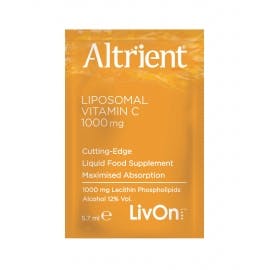Could a simple localised vitamin C deficiency give you a heart attack?
By Dr Levy MD
For the past century, scientific articles have continued to pour in showing that there are very many risk factors for heart disease, like elevated cholesterol, high blood pressure, diabetes, and so on. There is no question that such risk factors are clearly associated with heart disease, and, when uncontrolled, appear to accelerate its development. But, 'Preventative cardiology' is becoming the new medicine for heart health and Dr Levy explains why vitamin C is once again in the spotlight…
New viewpoint on atherosclerosis
In recent years, cardiology now appears to have collectively realized and accepted that coronary atherosclerosis (arterial narrowing and blockages) rarely develops in the absence of inflammation in the coronary arterial wall. Now, the thought process is, "Your coronary arteries are chronically inflamed, and we need to minimize that inflammation as best we can." The inflammation of the lining of the coronary arteries is the root of many coronary atherosclerosis which eventually leads to partially obstructive lesions, the acute formation of an occluding blood clot, and the resulting heart attack. Current thinking is that the presence of pathogenic oral bacteria, toxins and a focal vitamin C deficiency are involved in this coronary crisis.
Focal coronary arterial scurvy (localized vitamin C deficiency)
Normally, vitamin C is present literally everywhere in the body, both inside and outside the cells. All organs contain it and need it to function correctly and optimally. Most people, including healthcare practitioners, think of scurvy only as a severe vitamin C deficiency throughout the body that rarely occurs any longer in the modern world. And this is mainly correct. However, scurvy also occurs when vitamin C is severely depleted in one tissue or organ while the rest of the body has ample amounts. This is known as focal scurvy – which often exists in individuals who appear to be otherwise completely healthy. And where there is focal scurvy, there is focal inflammation…
Inflammation tents not to exist where there is no vitamin C deficiency. This is because inflammation results in increased oxidative stress (pro-oxidation), and such increased oxidative stress cannot exist where enough vitamin C (antioxidant) is present at the same time. So, any factor that increases oxidative stress consumes a proportionate amount of vitamin C, and any decrease in the ongoing supply of vitamin C to an area of the body allows oxidative stress to go unquenched, and this allows the clinical and laboratory evidence of vitamin C deficiency (aka focal scurvy) to appear.
Coronary artery wall infections and inflammation
So, why is there always inflammation and a state of focal scurvy in the coronary arterial walls? The only common way for the coronary artery to become severely deficient in vitamin C is to have pathogens take root there and metabolically consume (oxidize) all, or nearly all, of the vitamin C normally present. When this is occurring chronically, the result is chronic inflammation.
If there is a short-lived infection elsewhere in the body and only transiently releasing pathogens into the bloodstream, inflammation can come and go, and vitamin C levels can be restored. But when the pathogen supply in the blood is continuous, the inflammation remains. That inflammation then becomes the disease, as the macrophages and other immune system agents enter the inflamed area of the coronary artery and try to chronically "cure" the incessant seeding (spread) of pathogens. The increased oxidative stress due to the release of reactive oxygen species from the white blood cells resulting from the chronic inflammation in the absence of the vitamin C is the initiator and primary propagator of the atherosclerotic process. The bacterial seeding is precisely why inflammation "starts" in the diseased coronary artery. Infection/pathogen colonization always consumes local antioxidant (vitamin C) stores and inflammation results.
Where do these pathogens come from?
For some years now, cardiology and dental literature has shown that chronic periodontal disease (infected gums) is clearly "associated" with increased coronary artery disease. While this is true, it is finally becoming clear that this "association" is really cause-and-effect. That is to say, the oral pathogens directly cause the atherosclerosis. Multiple studies now reveal that blood vessel walls and atherosclerotic plaques contain the same array of pathogens found in infected gums. In addition, a much higher concentration of these pathogens has been found in blood clots that block the coronary artery and cause a heart attack.
Root canal bacterial seeding
A root canal is used in dentistry to restore typically very painful and grossly infected teeth back to a mechanically sound state, free of infection and pain. However, literature now clearly demonstrates that residual bacteria always remain in the accessory canals, dentinal tubules or remnants of pulp tissue. The microscopic dentinal tubules then harbor whatever pathogens were present indefinitely, typically producing a steady supply of enormously potent toxins which along with the pathogens seep into the circulation. Recent studies have been compelling in establishing the link between root canal-treated teeth and coronary heart disease. Even the Journal of the American Dental Association, in 2009, reported that individuals with root canal-treated teeth had more coronary heart disease than those without root canal-treated teeth.
Gum disease bacterial seeding
Apical periodontitis, an advanced form of gum disease that share the same pathogen profiles as are seen in root canal-treated teeth, has been found to seed those same pathogens directly into the coronary arterial wall, directly into the atherosclerotic plaque, and directly into the clots that acutely form to cause coronary artery obstruction and heart attack. Also, studies have now demonstrated the significant role that toxins from these pathogens play in the evolution of atherosclerosis leading to heart attack.
Other sources of bacterial seeding
Oral pathogens are the reason for well over 90% of heart attacks, and probably less than 5% of cardiologists and other physicians even know to look for this causative factor. The chronic infection of root canal-treated teeth is the source of the coronary inflammation for most heart attack patients, probably 70% of the time or so. Chronic gum disease probably accounts for another 20 to 25% of cases. The remainder comes from other unidentified sources chronically seeding pathogens into the blood, like infected tonsils or perhaps even a chronically constipated and pathogen-proliferating gut.
Preventative heart health
A heart attack patient is NOT just unlucky. Rather, the heart attack patient has an overwhelming likelihood of having a steady supply of oral pathogens and toxins coming from root canal-treated teeth and/or chronically infected gums. Bottom line, while nobody likes to get in the dental chair, avoiding the proper dental care and intervention can result in a much sicker and a much shorter life. Dr Levy suggests that every cardiologist needs to understand the significance of gum disease and the therapeutic benefits of liposomal vitamin C therapy. A good quality source or liposomal vitamin C is manufactured by LivOn Labs with the Altrient trade mark.
Please note - This article was created and edited by Food Scientist Susie Debice using extracts from the article The number one cause for 90 percent of all heart attacks by Dr Levy MD.
References
Haraszthy et al. (2000) Identification of periodontal pathogens in atheromatous plaques. Journal of Periodontology 71:1554-1560. PMID: 11063387
Mattila et al. (2005) Dental infections and cardiovascular disease: a review. Journal of Periodontology 76:2085-2088. PMID: 16277580
Caplan et al. (2006) Lesions of endodontic origin and risk of coronary artery disease. Journal of Dental Research 85:996-1000. PMID: 17062738
Caplan et al. (2009) The relationship between self-reported history of endodontic therapy and coronary artery disease in the Atherosclerosis Risk in Communities Study. Journal of the American Dental Association 140:1004-1012. PMID: 19654253
Willershausen et al. (2014) Association between chronic periodontal and apical inflammation and acute myocardial infarction. Odontology 102:297-302. PMID: 23604464
Ott et al. (2006) Detection of diverse bacterial signatures in atherosclerotic lesions of patients with coronary artery disease. Circulation 113:929-937. PMID: 16490835
Pessi et al. (2013) Bacterial signatures in thrombus aspirates of patients with myocardial infarction. Circulation 127:1219-1228. PMID: 23418311
Levy, T. (2001) Optimal Nutrition for Optimal Health. New York, NY: McGraw-Hill Publishing
http://healthimpactnews.com/2013/sweden-becomes-first-western-nation-to-reject-low-fat-diet-dogma-in-favor-of-low-carb-high-fat-nutrition/


.jpg?auto=format&q=45&w=262&trim=auto)
.jpg?auto=format&q=45&w=262&trim=auto)
